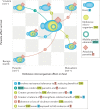Microbial evolution and transitions along the parasite-mutualist continuum
- PMID: 33875863
- PMCID: PMC8054256
- DOI: 10.1038/s41579-021-00550-7
Microbial evolution and transitions along the parasite-mutualist continuum
Abstract
Virtually all plants and animals, including humans, are home to symbiotic microorganisms. Symbiotic interactions can be neutral, harmful or have beneficial effects on the host organism. However, growing evidence suggests that microbial symbionts can evolve rapidly, resulting in drastic transitions along the parasite-mutualist continuum. In this Review, we integrate theoretical and empirical findings to discuss the mechanisms underpinning these evolutionary shifts, as well as the ecological drivers and why some host-microorganism interactions may be stuck at the end of the continuum. In addition to having biomedical consequences, understanding the dynamic life of microorganisms reveals how symbioses can shape an organism's biology and the entire community, particularly in a changing world.
© 2021. Springer Nature Limited.
Conflict of interest statement
The authors declare no competing interests.
Figures


Similar articles
-
Interactions between interactions: predator-prey, parasite-host, and mutualistic interactions.Ann N Y Acad Sci. 2008;1133:180-6. doi: 10.1196/annals.1438.007. Ann N Y Acad Sci. 2008. PMID: 18559821 Review.
-
The role of defensive symbionts in host-parasite coevolution.Biol Rev Camb Philos Soc. 2018 Nov;93(4):1747-1764. doi: 10.1111/brv.12417. Epub 2018 Apr 16. Biol Rev Camb Philos Soc. 2018. PMID: 29663622 Review.
-
Role of microorganisms in the evolution of animals and plants: the hologenome theory of evolution.FEMS Microbiol Rev. 2008 Aug;32(5):723-35. doi: 10.1111/j.1574-6976.2008.00123.x. Epub 2008 Jun 28. FEMS Microbiol Rev. 2008. PMID: 18549407 Review.
-
Evolutionary transitions in bacterial symbiosis.Proc Natl Acad Sci U S A. 2011 Jun 28;108 Suppl 2(Suppl 2):10800-7. doi: 10.1073/pnas.1100304108. Epub 2011 Jun 20. Proc Natl Acad Sci U S A. 2011. PMID: 21690339 Free PMC article.
-
Host and Parasite Evolution in a Tangled Bank.Trends Parasitol. 2016 Nov;32(11):863-873. doi: 10.1016/j.pt.2016.08.003. Epub 2016 Sep 3. Trends Parasitol. 2016. PMID: 27599631 Review.
Cited by
-
How It All Begins: Bacterial Factors Mediating the Colonization of Invertebrate Hosts by Beneficial Symbionts.Microbiol Mol Biol Rev. 2022 Dec 21;86(4):e0012621. doi: 10.1128/mmbr.00126-21. Epub 2022 Oct 27. Microbiol Mol Biol Rev. 2022. PMID: 36301103 Free PMC article. Review.
-
With a little help from my friends: the roles of microbial symbionts in insect populations and communities.Philos Trans R Soc Lond B Biol Sci. 2024 Jun 24;379(1904):20230122. doi: 10.1098/rstb.2023.0122. Epub 2024 May 6. Philos Trans R Soc Lond B Biol Sci. 2024. PMID: 38705185 Free PMC article. Review.
-
Melipona stingless bees and honey microbiota reveal the diversity, composition, and modes of symbionts transmission.FEMS Microbiol Ecol. 2024 Jun 17;100(7):fiae063. doi: 10.1093/femsec/fiae063. FEMS Microbiol Ecol. 2024. PMID: 38650068 Free PMC article.
-
Fungal Associates of Soft Scale Insects (Coccomorpha: Coccidae).Cells. 2021 Jul 29;10(8):1922. doi: 10.3390/cells10081922. Cells. 2021. PMID: 34440691 Free PMC article.
-
Nutrition-induced changes in the microbiota can cause dysbiosis and disease development.mBio. 2025 Apr 9;16(4):e0384324. doi: 10.1128/mbio.03843-24. Epub 2025 Feb 25. mBio. 2025. PMID: 39998180 Free PMC article.
References
-
- Law R, Dieckmann U. Symbiosis through exploitation and the merger of lineages in evolution. Proc. Biol. Sci. 1998;265:1245–1253.
-
- Wooldridge SA. Is the coral-algae symbiosis really ‘mutually beneficial’ for the partners? BioEssays. 2010;32:615–625. - PubMed
-
- Mushegian AA, Ebert D. Rethinking ‘mutualism’ in diverse host-symbiont communities. BioEssays. 2016;38:100–108. - PubMed
Publication types
MeSH terms
LinkOut - more resources
Full Text Sources
Other Literature Sources

